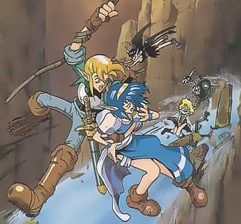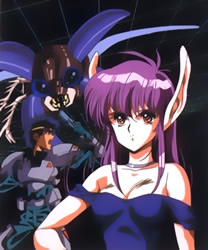Sega consoles have always been notoriously accused of suffering from a shortage of quality RPGs and indeed, RPG’s in general. Now a blind, deaf, mute would be able to tell you that this is simply not the case. So what happened? What made RPG’s so obscure that they were accused of not existing?
The history of Sega RPG’s begins back on the Master System. It is sad to say that there weren’t many RPGs there but instead a concentration of platformers and action games to take the cake. This was especially blatant compared to the NES which while not stuffed with RPGs, had more than enough to make Sega’s efforts seem pitiful. When Phantasy Star was released though, it marked a great change and leap forward for Sega’s popularity in the RPG department.
Stumbling Early
During the 16-bit era Sega had three great RPG series that rivaled Nintendo’s domination of the genre and caused Sega to make numerous other RPG’s. These famous successes were: Phantasy Star, Shining Force, and Lunar. Sega’s consoles also saw the release of some other great titles like Beyond Oasis, Crusader of Centy, Landstalker, Vay, Popful Mail, and Dark Wizard; with many others deserving of an honorable mention. And yet these wonderful games are overlooked, underappreciated and often supposedly do not exist. Where did Sega go wrong?
 Now it is a well known complaint from gamers when you hear, “Too trite!” “Too boring!” “Too cliché!” and “Why can’t you release something original?” The great companies heard this cry and they all took it seriously, but Sega took it far too seriously. In an attempt to appease their fans and gain more sales Sega fell into a most insidious mistake. Innovation for the sake of anything is good, although the results may be bad. Innovation for its own sake however is little more than a pitfall, one that Sega took.
Now it is a well known complaint from gamers when you hear, “Too trite!” “Too boring!” “Too cliché!” and “Why can’t you release something original?” The great companies heard this cry and they all took it seriously, but Sega took it far too seriously. In an attempt to appease their fans and gain more sales Sega fell into a most insidious mistake. Innovation for the sake of anything is good, although the results may be bad. Innovation for its own sake however is little more than a pitfall, one that Sega took.
For example, many people shied away from Crusader of Centy. The general feeling was that not only was it a Zelda clone, which was almost unbearable, but the plot was so weird. Who cared about the feelings of monsters? Who wanted to fight with fluffy animals? Actually, the unique gameplay element that featured the animals almost saved the game as it was fun in its own way, but too many people didn’t give it that much of a chance and seized the early weakness as a chance to put it down.
Other games fared little better, such as Beyond Oasis and Warsong. Both games were unfortunately somewhat obscure when released, and anti-Segaites and Nintendo fans found complaints that managed to carry weight. Beyond Oasis‘s story and spirit system, though interesting, were too cumbersome and slow moving. Warsong suffered from little more than obscurity, thankfully.
One of Sega’s greatest counters to the Zelda franchise was Landstalker. With great gameplay, sound, and story; it seemed sure to finally win the embattled organization some well-deserved praise. However, it was attacked on the grounds of its isometric view point, which made the controls and gameplay too clunky and irritating to be an easy option for the average gamer. Landstalker shrugged off the blow more easily than most Sega RPG’s did, as the claim was ridiculous and the controls were at most mildly frustrating until you got used to them, but the game did take a hit in immediate popularity.
So Misunderstood
You get the point I’m sure. Normally these attacks wouldn’t matter so much as a company’s big titles would carry them forward through rougher times. Unfortunately Sega had difficulty there too. The common complaints against the games usually run as follow: Phantasy Star — Never the right difficulty. Shining Force — Too easy and cliché. Lunar, on the other hand never took much punishment as the greatest attacks against it were minor quibbles that were by and large ignored. Ironically, the one game that received more praise than criticism was the one not created by Sega themselves.
Phantasy Star II was released shortly after the Genesis launched. It was immediately assaulted as being too hard and having some tediously uneventful hours at the beginning of the game. Shining in the Darkness was a little more obscure and was “too small” as well as having a “wimpy plot.” Shining Force was too easy. In my opinion, though, it was Phantasy Star III that shows what truly went wrong with Sega. The detour from the established series infuriated fans and sparked a famous controversy between fans that eliminated any need for Nintendo to do a thing against it.
 After the complaints levled against Phantasy Star II — though its fans vigorously defended it — all of the fans of Sega began debating the points brought to bear against each big release and a schism formed. With so many different opinions flying about, it was easy for gamers to accept the stereotype that Sega couldn’t do RPG’s very well rather than get mixed up in it.
After the complaints levled against Phantasy Star II — though its fans vigorously defended it — all of the fans of Sega began debating the points brought to bear against each big release and a schism formed. With so many different opinions flying about, it was easy for gamers to accept the stereotype that Sega couldn’t do RPG’s very well rather than get mixed up in it.
Sega did score a few times though. The release of Shining Force II shut up the sneering Nintendo fans for a little while. Phantasy Star IV, though accused of being too easy and too much of a rehash, remained insanely popular. The two Lunar games breezed by with very little in the way of complaints, but that would later haunt Sega. Nintendo fans used Lunar‘s popularity to piously claim that games like Vay and Dark Wizard just weren’t good enough. Shining Force CD must have given them nightmares until it was tested out and found to add fuel to the fanboy fire. The main thing that Shining Force II had to its credit was the absolute free roaming it allowed you. Nintendo most likely had a field day when it was revealed that SFCD had absolutely none.
Time is not Always Kind
In the end though, the propaganda convinced loyal Sega fans that there was little in the way of RPG’s (an entirely erroneous assertion, as evidenced by Sega-16’s RPG Round Up), and the majority of them were ready to play action games instead. It still pains me that Sega went down with Nintendo writing the history.

Recent Comments